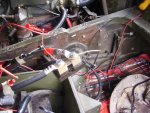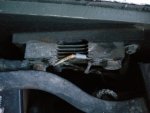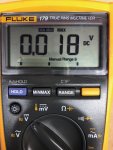You will NEVER see a volt or two across the shunt meter points in a HMMWV, UNLESS the shunt elements have detached or corroded away from the end poles. ( Can't afford those kind of voltage drops to run a HMMWV)
It is NOT a fuse or a regulator. In the case of a HMMWV, IF it blows open.... YOU GOT BIGGGGERRR problems.
This shunt is rated at 1000 Amps = 100 millivolts or mV. Basically a precision resistor. Adding the word shunt, usually invokes a need to measure a higher current than a standard wattage resistors using a voltmeter. OHMS LAW shows up again in the HumV.

In the case of the HMMWV at 1000 Amps of current flowing one would expect to see 100 millivolts or 0.100 volts. Very VERY small voltage.
So 0.050 Volts = 50 millivolts or 500 Amps. (that's a LOT of Amps) I weld with 10 to 250 Amps average 90 or less.
With a good starting engine, 75 degrees, average starter current 180 AMPS, you would measure 18 millivolts or .018 Volts
View attachment 800799
MY TRUCK STARTER RUNNING ONLY. INJECTOR SOLENOID DISCONNECTED. NO run condition. 180 Amps thru the shunt = 0.018 DC Volts.
One or two volt... I would run

and plug my ears

and wait for the fire department.


The picture IMO could use a little PM. The left connection bolt is easy to figure out. The right one is a feedthrough to the other side with lugged ground wire to starter frame ( your first ground to the rest of the truck).
It gets loose or mechanics fail to work the other side and properly tighten the whole assembly up. It's easy to do... just have to do it. More or less the same for the positive feedthrough too. Careful not to crack / bust the insulator on the HOT one.
Wire brush clean and properly tighten.... AND something to check on a new auction rig. Your picture looks to have been sparking and arcing, MG, My Guess.
The HMMWV shunt can be a useful diagnostic tool for charging, starting and glow plug current measurements, but for light loads like... lights, horn, heater motor, IP solenoids, etc. best to get in line with the circuit.
Always something to tighten, clean, check, wipe down, learn, etc, CAMO
AND don't forget to disconnect batteries when working.





